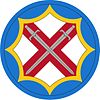| This article needs additional citations for verification. Please help improve this article by adding citations to reliable sources. Unsourced material may be challenged and removed. Find sources: "Battlefield surveillance brigades in the United States Army" – news · newspapers · books · scholar · JSTOR (June 2017) (Learn how and when to remove this message) |

The battlefield surveillance brigade (BfSB) was a United States Army surveillance/reconnaissance formation introduced from 2006 to 2015. The United States Army planned for the creation and transformation of nine intelligence brigades to a 'battlefield surveillance' role in 2007. The first battlefield surveillance brigade was deployed the same year conducting Intelligence, Surveillance and Reconnaissance (ISR) operations.
However, gathering information is only a part of the challenge it faces. Along with the structural changes and intelligence capabilities, the sustainment capabilities of the brigade also changed. The United States Army is currently reorganizing these BfSB formations into expeditionary military intelligence brigades. These brigades were designed to be self-sufficient Army modular forces.
Mission
The BfSBs were meant to improve situational awareness for commanders at division or higher so they can focus joint combat power in current operations while simultaneously preparing for future operations. The units had the tools to respond to the commanders needs from unmanned aerial vehicles to signals gathering equipment and human intelligence collectors. One of the major initiatives of the modernization plan involves migrating the army from a division-centric force designed to fight one or two potential major-theater wars toward a modular, brigade-centric force that is expeditionary in nature and deployed continuously in different parts of the world.
Structure

Each BfSB consisted of a headquarters and headquarters company; active component units have two military intelligence battalions while the Army National Guard BfSBs had one; each brigade had a reconnaissance and surveillance squadron consisting of a headquarters troop; two ground troops (Troops A and B) and a long-range surveillance (LRS) company; a signal company (network support company, or NSC); and a brigade support company (BSC). In 2012, the active component brigades started grouping the brigade HHC, the signal company, and the support company under a special troops battalion.
Transformation
Former units consisted of one Regular Army component and two reserve component detachments, there were both active-duty and National Guard surveillance brigades, each having a specific table of organization and equipment.
The changes made were all part of an Army-wide transition to the Army modular force, future-concept ("Grow The Army Plan" of modernization) proposed by US Army Chief of Staff General Peter Schoomaker in 2007. That plan called for ten Surveillance Brigades.
Former US Army Battlefield Surveillance Brigades
By 2015, five Battlefield Surveillance Brigades were reorganized into expeditionary military intelligence brigades. The rest were converted to other types of units or inactivated.
See also
References
- ^ "Army Times, November 2009". Army.mil. 13 November 2009. Retrieved 20 May 2011.
- "Supporting the Army's first Battlefield Surveillance Brigade, Army Logistician, Find Articles at BNET". Findarticles.com. Archived from the original on 9 July 2012. Retrieved 20 May 2011.
- "Army's New Battlefield Surveillance Brigades Ramping Up, Defense Daily, Find Articles at BNET". Findarticles.com. 10 February 2009. Archived from the original on 16 July 2012. Retrieved 20 May 2011.
- TIOH 201st BfSB
- IOAH 0504th BfSB
- BUnit Homepage Archived 29 January 2010 at the Wayback Machine









